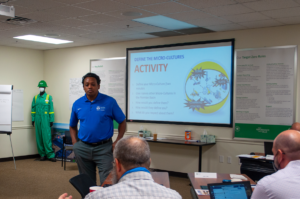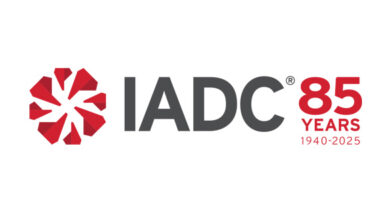Basin United safety orientation targets significant injuries, fatalities
Industry set to roll out new IADC-managed Building the Basin course that aligns with updated RigPass
By Jessica Whiteside, contributor

Which is more likely to help you remember a lesson about jobsite safety hazards: a flood of PowerPoint slides or a hands-on simulation? An industry-led group of upstream stakeholder companies in the Permian Basin is betting the latter. They’ve banded together as Basin United to launch a new safety orientation to help the region’s newest workers retain essential life-saving lessons.
“Basin United provides a different approach to safety orientation,” said Matt Streams, Safety Advisor with ExxonMobil, one of 16 operators in the Basin United network. “It leverages videos, interactive gaming/virtual reality, scenarios/role-playing, hands-on activities and incident analysis to teach workers to recognize hazards and understand the safeguards that can protect them.”
He described Basin United as being created by industry and for the industry, to share knowledge and enhance learning. “Working together, we can better educate, empower and protect our Permian workforce.”
Developed in collaboration with IADC and the then Association of Energy Service Companies (AESC, now the Energy Workforce & Technology Council), Basin United’s new Building the Basin program is a two-day workforce orientation and leadership training course aimed at new field workers in the Permian Basin. Rookies are at particular risk: IADC incident statistics show that rig workers with less than six months on the job are the most likely to suffer an accident.
“It’s very easy for us to expect people to recognize a hazard and call a time-out, but if they’ve never seen that hazard before and they don’t understand the hazard, it’s an unreasonable expectation,” said Mike Garvin, Senior Vice President Operations at Patterson-UTI, which participated in pilot testing of the program. “New employees are severely lacking knowledge. Our job is to get them to slow down a bit, look around and think ahead. Hopefully, we can make them comfortable to act upon their instincts.”
While initial implementation of Building the Basin focuses on the Permian, a rollout across the US could be in the program’s future, although there is no timeline yet.
Building safety awareness and leadership
Building the Basin will be launched in the Permian Basin in March. Organizations whose employees are contractually required to complete the course will then have a six-month grace period to prepare for course delivery or attendance. Each course day lasts eight to nine hours and can be delivered separately or in combination with the other day.
Day 1 targets all new frontline workers and supervisors in the Permian who have not already taken an industry-recognized safety orientation, such as IADC’s RigPass program (check with your operator to confirm which orientations they accept as preferences may vary). The curriculum explores the fundamentals of work site safety, including life-saving actions, hazard recognition and individual safety leadership responsibilities.
Day 2, for supervisors only, helps participants practice the leadership skills they’ll need to improve safety and productivity at their sites. A prerequisite is completion of either Day 1 of Building the Basin or an industry-recognized safety orientation (check with your operator to confirm which orientations they accept). The Day 2 course, which must be refreshed every two years, digs deeper into leadership concepts and human performance principles, Mr Streams said.
“By specifically targeting field leadership for this next-level day of interactions and learnings, the group hopes to build an even stronger safety culture across the Permian Basin,” he explained.
The full Building the Basin course went through four rounds of pilot testing with industry field personnel in 2020 and early 2021. The development team, which included cross-sector representation, adjusted content or delivery as needed after each round, based on feedback from participants, trainers and observers to make sure messages hit the mark.
“When it comes to instructional design, that pilot phase is crucial,” said Brooke Polk, IADC’s Senior Director of Accreditation Operations.
Seeking better student engagement
Mandatory safety orientation for new workers has been a central tenet of safety programs across the oil and gas sector for years. But when the Permian’s pre-pandemic E&P boom triggered an escalation in significant injuries and fatalities – deaths rose from 63 in 2016 to 94 in 2018 – the Basin United operators began exploring ways to make these orientations more effective.
IADC also expressed concerns about the quality and consistency of other safety orientations. Orientations that relied on instructor-focused, PowerPoint-heavy delivery methods no longer met the mark for many in the industry. They did not reflect modern best practices in adult learning or advances in instructional technology.
Orientations dominated by PowerPoint presentations can be “pretty dry,” said Kenny Jordan, Vice President of the Energy Workforce & Technology Council. The interactive delivery methods employed by Building the Basin mark a much different approach for the industry when it comes to safety orientation, he added. “There’s a lot more thought given to how humans learn and interact.”
Much of the Building the Basin course is scenario-based, Mr Garvin explained, noting that his company takes a similar approach with its in-house safety training.
“The employees don’t sit in a chair for more than 20 to 30 minutes at a time. They’re up doing something, whether they’re working at a flip chart, they’re working in a team, or they’re delivering back to the group,” he said. “If you really want to engage them and get them to learn something, they have to be active in the learning process.”
Harmonizing with RigPass
As Basin United began developing its new, interactive orientation for the Permian, IADC was in the process of enhancing the interactive delivery aspects of its own global RigPass orientation, spurred by the continuous improvement approach that’s allowed the program to evolve with industry needs over the past 25 years.
Initially, both drilling and service companies feared that Basin United’s introduction of another orientation standard could lead to contractors paying for multiple safety orientations, depending on operator preference.
However, when it became apparent that both Basin United and IADC were pursuing similar goals in terms of instructional best practices, learner engagement and quality control, they decided to work together to pursue alignment between their curriculums. IADC and AESC became members of the Basin United steering committee; IADC also joined the program’s development and delivery teams. RigPass had always exceeded industry requirements; now it would adapt to Basin United expectations, as well.
The result of this intense collaboration is that most of Basin United’s Day 1 orientation curriculum aligns directly with RigPass, with the exception of 10 additional learning objectives tailored to Permian operator preferences. Among the differences are driving incident statistics specific to the Permian Basin that would not be germane to the globally applicable RigPass.
This alignment means that users requiring a safety orientation can take a combined “RigPass with Basin United” course that covers both RigPass and the additional learning objectives from Day 1 of Building the Basin in a single, one-day session. The combined course is endorsed by Basin United, and participants will earn credentials for both RigPass and the Building the Basin Day 1 orientation. Day 2 is not part of the combined course and would be taken separately if needed. This option is ideal for contractors who work both with Permian operators requiring Basin United and other operators requiring RigPass.
Companies can take RigPass or the Basin United orientations separately if they do not require both credentials, but Ms Polk predicted the combined course will be popular because of the flexibility it gives contractors to meet different operator preferences. She called the combined course “a win-win for industry” because there’s no additional cost and no additional time to get both credentials.
“We definitely do not want to have unnecessary duplicative training. That’s going to remain our goal and our focus,” she added.
Managing accreditation
Basin United has tapped IADC to manage the administration and accreditation processes for the Building the Basin program. IADC is the only safety orientation accrediting body in the oil and gas sector that is ISO certified for quality management systems, having held ISO 9001 certification for 15 years, Ms Polk said.
Mr Jordan called Basin United’s move to make IADC the official accrediting body for the course a “wise decision.”
“IADC is well set up in order to maintain that process. They have the procedures, the personnel and the infrastructure in place to handle all that,” he said.
The Building the Basin course and the combined “RigPass with Basin United” option can be delivered by a company’s in-house safety trainers or by commercial training providers. While these courses would normally require in-person attendance, the COVID-19 situation means distance learning is also an option, Ms Polk said.
Building the Basin Day 1 trainers will have to meet a set of requirements similar to those for RigPass, including industry experience, instructional experience and experience instructing in HSE. Trainers who want to lead the Day 2 course for supervisors must first take the new Basin United facilitator course, a two-day session that provides coaching on the facilitation of experiential learning activities.
To support course delivery, accredited trainers can access a “to go” resources package featuring student and facilitator guides covering all required activities. As with RigPass, training organizations can also develop their own custom materials for Building the Basin as long as they meet the curriculum and assessment requirements. DC
Click here for more information on Basin United.




